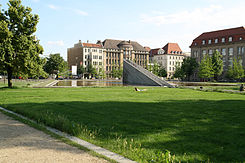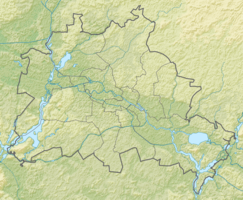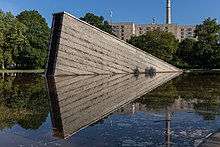Invalidenpark
| Invalidenpark | ||
|---|---|---|
| Park in Berlin | ||

|
||
|
Invalidenpark and Mauerbrunnen, view towards Invalidenstrasse , 2009 |
||
| Basic data | ||
| place | Berlin | |
| District | center | |
| Created | 1843 | |
| Newly designed | 1995-1997 | |
| Surrounding streets | Habersaathstrasse, Schwarzer Weg, Invalidenstrasse , Scharnhorststrasse |
|
| use | ||
| User groups | Foot traffic ; Leisure , events | |
| Park design | Peter Joseph Lenné | |
| Technical specifications | ||
| Parking area | 25,000 m² | |
|
52 ° 31 '45 " N , 13 ° 22' 35" E
|
||
The Invalidenpark is a historical green area . It is located in the Berlin district center near the Berlin Central Station Road square Habersaathstraße / Schwarzer Weg / invalidity road / Scharnhorststraße and comprises about 2.5 hectares .
history
In the 18th century, the area served the inmates of the disabled house as a kitchen garden for self-sufficiency. It was rededicated as a park in 1843 and probably designed by Peter Joseph Lenné . In the complex, which has been open to the public since 1850, the invalids column was erected from 1854 in honor of the Prussian soldiers who died in the revolution of 1848/1849 and in the German-Danish War from 1848 to 1851 , and it was built in memory of Empress Augusta between 1891 and 1895 Mercy Church . After the devastation in World War II , the destruction of the invalids' column in 1948 and the demolition of the church, which was ruined in the post-war period, in 1967 , the green area not far from the border facilities of the Berlin Wall fell into disrepair during the GDR era .
Redesign and description
From 1992 to 1997, today lined ministries open space was given a new shape as a transition between the park and the urban space designed by the French landscape architecture office Atelier Phusis with Christophe Girot . On the north side there is an old stock of trees, while to the south there is a lawn that finally changes into a granite paving. In the lawn there is a basin , in the middle of which a narrow, walkable granite sculpture (sunken wall) protrudes from the water. Girot interprets it as a "trace into the future". It is intended to commemorate the Gnadenkirche, which formerly stood there and was destroyed in the Second World War, as well as the nearby Berlin Wall . The Berlin Senate calls the waterworks the sinking wall , previously also known as the wall fountain or the invalid's fountain .
Medial
The water system can be seen in the opening shot of the film Brüno by Sacha Baron Cohen and is supposed to show that Brüno is in Vienna.
literature
- Markus Sebastian Braun (Editor): Berlin - The Architecture Guide . Econ Ullstein List, Munich 2001, ISBN 3-88679-355-9 , p. 254.
- Udo Weilacher: Invalidenpark in Berlin. In the coordinate system of the city's history . In: Udo Weilacher: In gardens. Profiles of current European landscape architecture. Basel / Berlin / Boston 1999, ISBN 978-3-7643-7084-8 , pp. 43–54, 59–64.
Web links
- Invalidenpark . In: District lexicon of the Luisenstädtischer Bildungsverein
- Invalidenpark on gruen-berlin.de.
Individual evidence
- ↑ Monument Sinking Mauer (Girot's fountain). Senate Department for Urban Development, accessed on October 7, 2019 .


